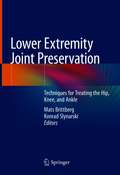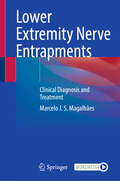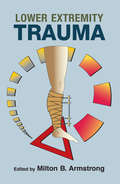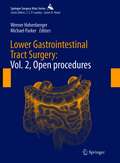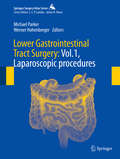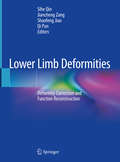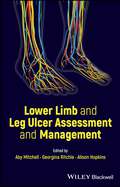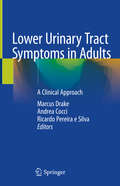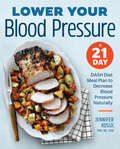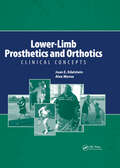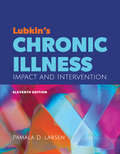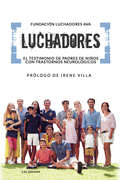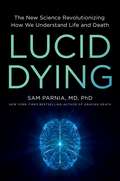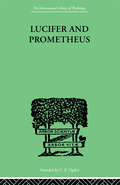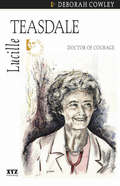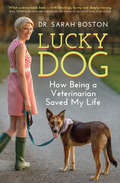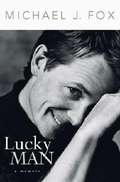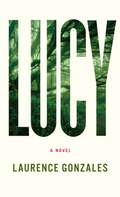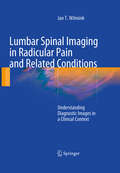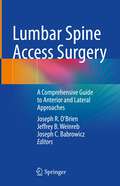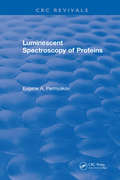- Table View
- List View
Lower Extremity Joint Preservation: Techniques for Treating the Hip, Knee, and Ankle
by Mats Brittberg Konrad SlynarskiThis book describes and discusses the available joint preservation techniques for maintaining the stability homeostasis of the lower extremity joints – specifically the hip, knee, and ankle – following injury. Readers will find detailed coverage of anatomy, pathology, techniques for repair, restoration, and regeneration, and rehabilitation strategies. Joint preservation is an emerging field in Orthopaedics that represents a response to the limitations of joint replacement technology. Using the techniques now available, surgeons can try to prevent or delay the onset of osteoarthritis or other degenerative conditions affecting the joints, particularly in young patients. Furthermore, modern tissue engineering offers the potential for whole-joint resurfacing, thereby achieving complete restoration. Optimal implementation of these techniques depends upon further refinement of methods and continuing improvements in knowledge of biomechanics, biology, and anatomy. Against this background, the present book is an ideal guide to the latest treatment modalities that will appeal to all who wish to learn more about indications, goals, procedures, and expected outcomes.
Lower Extremity Nerve Entrapments: Clinical Diagnosis and Treatment
by Marcelo J. MagalhãesThis book offers a comprehensive and in-depth exploration of lower limb nerve entrapments, integrating anatomical, diagnostic, and therapeutic perspectives. The journey begins with an examination of the epidemiology, shedding light on its prevalence and distribution. Building on this foundation, readers delve into the general aspects of neuropathies, gaining insights into the various manifestations and underlying mechanisms of nerve disorders affecting the lower limbs. The text includes detailed descriptions of the anatomy, meticulously addressing the structure and function of lower limb nerves. It also features Common Peroneal Nerve Entrapment, including its etiology, diagnosis, and treatment, as well as Anterior and Posterior Tarsal Syndrome, Meralgia Paresthetica, Piriformis Syndrome, and other rare syndromes of lower limbs, including clinical presentations and therapeutic approaches. Relevant complementary exams, such as surgical techniques, interventions, and management strategies, are discussed to optimize patient outcomes in these painful conditions. A chapter is dedicated to the use of tendon transfer as a treatment option, providing guidance for managing the aftermath of nerve injuries in lower limbs. It is also richly illustrated with videos of surgical techniques. Lower Extremity Nerve Entrapment – Clinical Diagnosis and Treatment is an essential resource that equips neurosurgeons, orthopedic surgeons, and plastic surgeons - both aspiring and experienced - with the knowledge necessary to diagnose and manage the complexities of peripheral nerve disorders. From epidemiology to treatment strategies, this book equips readers with insights needed to excel in the challenging field of neurosurgery.
Lower Extremity Trauma
by Milton B. ArmstrongWith an abundance of case studies from Jackson Memorial Hospital, this reference provides expert guidance on the evaluation and treatment of lower extremity orthopedic injuries. Analyzing the function and interrelationships of the muscular and skeletal systems of the lower extremities, this source discloses key principles in trauma management, deci
Lower Gastrointestinal Tract Surgery: Vol. 2, Open procedures (Springer Surgery Atlas Series)
by Michael Parker Werner HohenbergerThis atlas, containing a wealth of clear operative images, is designed to enable trainee surgeons to visualise the surgical field for procedures specific to open colorectal surgery, thereby facilitating understanding and learning of surgical techniques and avoidance of intra- and postoperative complications. Step-by-step guidance is provided for a wide range of procedures to the colon, rectum, pelvic floor, anus and anal canal, in each case paying meticulous attention to surgical anatomy. The full range of potential indications for open surgery is considered, including benign and malignant tumours, inflammatory bowel disease, appendicitis, diverticulitis, hemorrhoids, anal fistulas and rectal prolapse among others. Whenever considered necessary, additional line drawings are included to aid comprehension of particular steps in the surgery. Readers seeking to improve their understanding of surgical anatomy and how to perform these operative procedures will find the atlas to be an unparalleled source of information and assistance. A complementary book from the same authors focuses on laparoscopic colorectal surgery.
Lower Gastrointestinal Tract Surgery: Vol.1, Laparoscopic procedures (Springer Surgery Atlas Series)
by Michael Parker Werner HohenbergerThis atlas, containing a wealth of clear operative images, is designed to enable trainee surgeons to visualise the surgical field for procedures specific to laparoscopic colorectal surgery, thereby facilitating understanding and learning of surgical techniques and avoidance of intra- and postoperative complications. Step-by-step guidance is provided for a wide range of procedures employed in patients with benign and malignant tumours, inflammatory bowel disease, diverticular disease, rectal prolapse and other conditions. Examples include right colectomy techniques, sigmoid colectomy, left hemicolectomy, total colectomy, panproctocolectomy, total mesorectal excision, Hartmann’s procedure and its reversal and rectopexy. Throughout, meticulous attention is paid to surgical anatomy. Whenever considered necessary, additional line drawings are included to aid comprehension of particular steps in the surgery. Readers seeking to improve their comprehension of surgical anatomy and how to perform these operative procedures will find the atlas to be an unparalleled source of information and assistance. A complementary book from the same authors focuses on open colorectal surgery.
Lower Limb Deformities: Deformity Correction and Function Reconstruction
by Sihe Qin Jiancheng Zang Shaofeng Jiao Qi PanThe diagnosis and treatment described in this book is based on the combination of Ilizarov technique, Paley’s principle and Qinsihe Natural Reconstruction theory. It covers all kinds of lower limb deformities, ranging from congenital deformities to acquired deformities, the sequelae of Poliomyelitis, Cerebral Palsy, Spina Bifida Sequelae, Traumatic Sequelae, Charcot-Marie-Tooth disease, Osteogenesis Imperfecta and Congenital Pseudarthrosis Tibia, etc. There are also lots of clinical tips and tricks such as how to reduce radiation exposure during orthopaedic surgeries, how to correct multiple limb deformities in one stage, how to balance the dynamic muscle in complex foot and ankle deformities, and how to successfully accomplish the surgery of difficult lower limb reconstruction without allogeneic blood transfusion, etc.It is a valuable reference for orthopaedic surgeons and advanced trainees worldwide who interested in deformity correction and limb reconstruction.
Lower Limb and Leg Ulcer Assessment and Management
by Aby Mitchell Georgina Ritchie Alison HopkinsLower Limb and Leg Ulcer Assessment and Management Lower Limb and Leg Ulcer Assessment and Management is an indispensable resource for practitioners in primary and secondary care, offering a practical and accessible guide to treating and managing leg ulcers. This comprehensive text challenges the misconception that leg ulcers are invariably ‘chronic’. In practice, proactive management will prevent the harm associated with sub-optimal management. Insights are provided into lower limb assessment, early intervention for ulcer prevention, ulcer types and their causes, along with the influence that swelling and biomechanical changes have on the lower limb. The authors draw on international best practice guidance on lymphoedema, wound pain, wound bed preparation, compression therapy, psychological impact, and evidence-based care to enhance leg ulcer management. Each chapter aims to facilitate reader comprehension and promote productive patient discussions, empowering healthcare professionals to collaborate with patients and improve leg ulcer management rapidly and effectively. This multi-disciplinary resource covers: Normal venous, arterial, and lymphatic function in the lower leg Leg ulceration due to venous hypertension, peripheral arterial disease, and lymphoedema Leg ulcers of unusual aetiology, addressing autoimmune and inflammatory disorders such as pyoderma gangrenosum, rheumatoid arthritis, scleroderma, sickle cell, and more Musculoskeletal changes in the lower limb, assessment, and management to enhance mobility and calf-muscle function Clinical management, with topics like wound management, stages of wound healing, exudate management, holistic assessment including vascular assessment, compression therapy, and Laplace’s law Pain management with an emphasis on understanding the complexities and features that exacerbate or diminish the pain response The personalisation of care, understanding of social determinants of health, and the role of supportive self-management in lifelong management For professionals seeking evidence-informed approaches to delivering exceptional care, Lower Limb and Leg Ulcer Assessment and Management is an essential companion on the journey to understanding and managing leg ulcers effectively.
Lower Urinary Tract Symptoms in Adults: A Clinical Approach
by Marcus Drake Andrea Cocci Ricardo Pereira e SilvaThis book provides an in-depth insight into the symptoms and symptom complexes affecting the lower urinary tract and the underlying causative conditions. The emphasis throughout is practical and clinical, with coverage of all levels of the patient pathway. In addition to the extensive guidance on diagnostic assessment and interpretation, the management of voiding and storage lower urinary tract symptoms, including incontinence, is fully described and potential complications and neurological conditions are discussed. Information is also included on relevant basic science and epidemiology. Lower Urinary Tract Symptoms in Adults: A Clinical Approach will be an ideal source of expert knowledge for practitioners in functional urology, urogynecology, and neuro-urology gerontology. .
Lower Your Blood Pressure: A 21-Day DASH Diet Meal Plan to Decrease Blood Pressure Naturally
by Jennifer Koslo RNDEat your way to lower blood pressure. There are ways to help treat high blood pressure that don't require medications with unpleasant side effects. Lower Your Blood Pressure provides you with the guidance you need to manage your hypertension with the foods you eat. It's also filled with heart-healthy advice and delicious DASH (Dietary Approaches to Stop Hypertension) diet recipes. The DASH diet focuses on improving your blood pressure using foods that are low in sodium and high in magnesium and potassium. New to DASH? Lower Your Blood Pressure makes things easy with a three-week meal plan—complete with shopping lists—designed to get you started on the right (and yummy) path. Lower Your Blood Pressure includes: 21-day meal plan—Jump right into healthy eating with a simple and straightforward meal plan that helps you adjust to the DASH diet in just three weeks. 75+ quick and easy recipes—From Stuffed Breakfast Peppers to Pecan-Crusted Catfish, start deciding your own meals using these healthy and mouthwatering options. Hypertension explained—Learn all about how to manage your blood pressure naturally, including dietary goals, de-stressing tips, exercise advice, and more. Take the pressure off with this complete dietary guide to lowering your blood pressure.
Lower-Limb Prosthetics and Orthotics: Clinical Concepts
by Joan Edelstein Akex MorozLower-Limb Prosthetics and Orthotics: Clinical Conceptsis a comprehensive overview of lower-limb prosthetics and orthotics, covering normal and pathological gait, lower-limb biomechanics, clinical applications, as well as prosthetic and orthotic designs and components. Joan Edelstein and Alex Moroz have writtenLower-Limb Prosthetics and Orthotics with the clinician’s perspective in mind. Clinical management is incorporated throughout the text, including basic surgical concepts, postoperative management, preprosthetic care, and training in the use of devices. Additionally, this text incorporates unique features relevant to physicians such as prescription writing and prosthetic and orthotic construction and modification, as well as, the latest research regarding energy consumption and long-term utilization of prostheses.Chapters Include: Orthotics in neuromuscular diseases Orthotics in pediatrics Functional expectations Gait and activities training Transtibial and transfemoral prostheses and components Transtibial and transfemoral biomechanics, evaluation, and gait analysis Disarticulations and Bilateral Amputations With over 150 line drawings and photographs to supplement the text, Lower-Limb Prosthetics and Orthotics: Clinical Concepts is ideal for clinicians in the fields of physical medicine and rehabilitation, orthopedics, vascular surgery, physical therapy and occupational therapy.
Lu's Basic Toxicology: Fundamentals, Target Organs, and Risk Assessment (7th Edition)
by Byung-Mu Lee Sam Kacew Hyung Sik Kim<p>Continuing a long tradition, Lu’s Basic Toxicology, Seventh Edition, combines relatively comprehensive coverage of toxic substances in food, air, and water with brevity, thereby continuing to serve as an updated introductory text for toxicology students and for those involved in allied sciences that require a background in toxicology. The new edition, which now becomes an edited work with contributions from experts around the globe, features four new chapters and a number of existing chapters that have been updated and expanded, notably those on mechanisms of toxic effects, conventional toxicity studies, the cardiovascular system, and risk assessment and regulatory toxicology. <p>The book consists of four parts (Part I–Part IV) that provide guidance on principles of toxicology and testing procedures for toxicities as well as a concise, yet detailed, mechanism of both target organ and nontarget organ toxicities. The book is rounded off with a final section (Part IV) on the toxic effects of chemicals and risk assessment, giving toxicologists, both students and practicing professionals, the necessary tools to enhance their practice. This edition includes new chapters on Clinical Toxicology, Systems Toxicology, Chemicals and Children, and Toxicology of Reproductive Systems, providing the essentials of these topics in the same style as the other chapters in the book. With separate subject and chemical indexes, this is a useful, quick shelf reference for everyone working in toxicology today.</p>
Lubkin's Chronic Illness: Impact and Intervention
by Pamala D. Larsen. Lubkin’s Chronic Illness: Impact an Intervention, Eleventh Edition provides a solid foundation for nursing students by teaching them the skills and knowledge they need to care for patients experiencing illness.
Luchadores: El testimonio de padres de niños con trastornos neurológicos
by Fundación Luchadores AvaPrólogo de Irene Villa. «Tienen en sus manos un libro sobrecogedor que inquieta pero nos llena de amor y esperanza, es un auténtico alegato de vida, de encontrar la forma y la actitud necesarias para luchar sin descanso y de no rendirse jamás». Irene Villa. Esta es una obra, ante todo, alegre, optimista, motivadora, inspiradora un canto a la vida. Un libro que te hará llorar y reír, y que sacará lo mejor de ti. Te hará ver la vida de otra manera y afrontarla con mayor fuerza y alegría. A través de él vivirás más de once vidas, las vidas de once padres y un abuelo que te contarán cómo afrontan la enfermedad de su hijo. No los oirás quejarse o maldecir su suerte. Te hablarán del amor que sienten por sus hijos, de cómo han cambiado sus vidas, sus prioridades y su forma de pensar. Te enseñarán a afrontar los pequeños o grandes problemas diarios mediante sus propias vivencias y, sobre todo, te irás con una gran lección: que el amor que siente un padre por su hijo todo lo puede. Conocerás la lucha diaria de estos niños que no tienen voz, queson los grandes olvidados de una sociedad atareada que ha perdido sus valores. Niños que con sus grandes sonrisas y sus ganas de vivir son capaces de cambiar a cualquiera que se cruce en su camino y se detenga a conocerlos. ¡Déjate cambiar por ellos!
Lucid Dying: The New Science Revolutionizing How We Understand Life and Death
by Sam ParniaFrom internationally renowned expert in resuscitation and New York Times bestselling author Sam Parnia, MD, PhD, comes a groundbreaking look at what happens to us when we die, based on the largest-ever research study run on recalled experiences of death. Today, for the first time in history, the scientific exploration of death and what happens when we die is real, active and ongoing. Contrary to popular perceptions, this subject is no longer the remit of philosophy, religion, or personal opinion. Truly remarkable scientific discoveries that will fundamentally affect everyone&’s lives now and in the future are taking place, yet very few people are aware of them. Most people—including scientists and doctors—maintain strong beliefs about death and its experience. Those beliefs are rooted in traditional, and often cultural, notions of death. But what if all that we have come to believe about death is fundamentally wrong? What if the paradigm we have been operating within no longer exists? What if death is not the end we thought?Lucid Dying is the first book to share that science. Presenting data derived from multiple groundbreaking studies, Dr. Parnia shows that the entity we refer to as consciousness—our Self—does not seem to become annihilated when we die. In fact, during death, our consciousness vastly expands and leads to a vivid experience that follows a very specific narrative arc. These studies support that there really is a universal experience of death that is meaningful, transcendent, positive, and transformative—not hallucinatory, delusional, or illusory as previously imagined. In his latest book, Dr. Parnia weaves empirical research with gripping stories to show us the truth of how death is not the end we all thought and how anyone can harness the newfound wisdom to lead deeper, more intentional lives.
Lucifer and Prometheus: A STUDY OF MILTON'S SATAN
by R J WERBLOWSKYRoutledge is now re-issuing this prestigious series of 204 volumes originally published between 1910 and 1965. The titles include works by key figures such asC.G. Jung, Sigmund Freud, Jean Piaget, Otto Rank, James Hillman, Erich Fromm, Karen Horney and Susan Isaacs. Each volume is available on its own, as part of a themed mini-set, or as part of a specially-priced 204-volume set. A brochure listing each title in the "International Library of Psychology" series is available upon request.
Lucille Teasdale
by Deborah CowleyCanadian surgeon Lucille Teasdale and her husband founded Lacor Hospital in northern Uganda in 1961. For 35 years the two doctors treated such contagious diseases as malaria, TB, and AIDS, and Teasdale performed thousands of operations under difficult conditions. They lived through civil war, hostage takings, and epidemics. Teasdale received the highest humanitarian awards from the U.N. for her lifes work in Africa.
Lucky Dog: How Being a Veterinarian Saved My Life
by Sarah BostonLucky Dog is a hilarious and heartwarming memoir by a renowned veterinary oncologist who tells us what we can learn about health care and ourselves from our most beloved pets.What happens when a veterinary surgical oncologist (laymen’s term: cancer surgery doctor) thinks she has cancer herself? Enter Sarah Boston: a vet who suspects a suspicious growth in her neck is thyroid cancer. From the moment she uses her husband’s portable ultrasound machine to investigate her lump — he’s a vet, too — it’s clear this will not be your typical cancer memoir.She takes us on a hysterical and thought-provoking journey through the human health care system from the perspective of an animal doctor. Weaving funny and poignant stories of dogs she’s treated along the way, this is an insightful memoir about what the human medical world can learn from the way we treat our canine counterparts. Lucky Dog teaches us to trust our instincts, be our own advocates, and laugh while we’re doing it.
Lucky Man
by Michael J. FoxIn September 1998, Michael J. Fox stunned the world by announcing he had been diagnosed with Parkinsons disease degenerative neurological condition. In fact, he had been secretly fighting it for seven years. The worldwide response was staggering. Fortunately, he had accepted the diagnosis and by the time the public started grieving for him, he had stopped grieving for himself. Now, with the same passion, humor, and energy that Fox has invested in his dozens of performances over the last 18 years, he tells the story of his life, his career, and his campaign to find a cure for Parkinsons. Combining his trademark ironic sensibility and keen sense of the absurd, he recounts his life from his childhood in a small town in western Canada to his meteoric rise in film and television which made him a worldwide celebrity. Most importantly however, he writes of the last 10 years, during which with the unswerving support of his wife, family, and friends he has dealt with his illness. He talks about what Parkinsons has given him: the chance to appreciate a wonderful life and career, and the opportunity to help search for a cure and spread public awareness of the disease. He is a very lucky man, indeed.
Lucy
by Laurence GonzalesLaurence Gonzales's electrifying adventure opens in the jungles of the Congo. Jenny Lowe, a primatologist studying chimpanzees--the bonobos--is running for her life.A civil war has exploded and Jenny is trapped in its crosshairs . . . She runs to the camp of a fellow primatologist.The rebels have already been there.Everyone is dead except a young girl, the daughter of Jenny's brutally murdered fellow scientist--and competitor.Jenny and the child flee, Jenny grabbing the notebooks of the primatologist who's been killed. She brings the girl to Chicago to await the discovery of her relatives. The girl is fifteen and lovely--her name is Lucy.Realizing that the child has no living relatives, Jenny begins to care for her as her own. When she reads the notebooks written by Lucy's father, she discovers that the adorable, lovely, magical Lucy is the result of an experiment. She is part human, part ape--a hybrid human being . . . Laurence Gonzales's novel grabs you from its opening pages and you stay with it, mesmerized by the shy but fierce, wonderfully winning Lucy.From the Hardcover edition.
Luft und Gesundheit: Von der globalen Zirkulation bis zu Atemwegserkrankungen
by Christian RügerIst frische Luft ein Mythos? In diesem Werk durchstreift der Autor die Lebensräume des Menschen und bietet Einblicke in die jeweils anzutreffenden Luftqualitäten. Aerosole steigen nicht von allein in die Luft auf. Die Partikel lösen sich aus dem festen oder flüssigen Verband. In der Luft kommen alle flugfähigen Masseteilchen miteinander in Kontakt – als ein anschauliches Beispiel dient dem Leser die Entstehung von Wassertropfen. Jede Luftschicht der Atmosphäre wirkt unterschiedlich auf die Atemluft ein und der Wind spielt dabei seine ganz eigene Rolle. Einerseits ist er Verteiler von Schadstoffen, und andererseits Garant frischer Luft am Erdboden. Die Verschmutzung der Luft ruft den Gesetzgeber auf den Plan. Wir erleben derzeit eine rasante Entwicklung von der Aufhebung der Zünfte bis zur Klimadiskussion.Große Relevanz für die Gesundheit besitzt die Schnittstelle zwischen Luft und Mensch: die Atemwege. Deren Schleimhäute stehen im Zentrum unserer Immunabwehr, und müssen einen „Etagenwechsel“ von Infektionen der oberen Atemwege in untere Lungenabschnitte verhindern. Diese und viele weitere spannende Zusammenhänge und Themen im breiten Spektrum zwischen Meteorologie und Atemwegserkrankungen werden anschaulich, gut zugänglich und anhand praktischer Beispiele abgehandelt, um sich eine sichere Plattform zur Beurteilung der Flut von Umweltnachrichten zu schaffen.
Lumb and Jones' Veterinary Anesthesia and Analgesia (Fourth Edition)
by Kurt A. Grimm John C. Thurmon William J. Tranquillish. Later chapters provide detailed coverage of important considerations for specific diseases and types of patients and procedures, including new chapters on the anesthetic management of dental, cancer, orthopedic and equine colic patients. Preliminary sections cover the general principles of anesthesia, physiology and pharmacology, equipment and monitoring, and anesthetic and analgesic techniques. New edition of the definitive reference in veterinary anesthesia. Expanded focus on pain management. Written by international team of experts including more than 65 contributing authors. Covers anesthesia management of domestic and wild species and full array of clinical conditions and diseases.
Lumbar Spinal Imaging in Radicular Pain and Related Conditions
by J. T. WilminkA general consensus exists,that lumbosacral nerve root compression is the primary cause of sciatica and neurogenic claudication, although humoral and vascular factors certainly play a role as well. This book focuses on imaging the various ways in which nerve root compression can come about, and determining which anatomic features are reliably associated with the production of radicular pain. After a discussion of the nature of radicular pain and related symptoms, spinal imaging techniques and options are reviewed, with emphasis on the role of MR myelography in assessing the intradural nerve roots. A chapter on normal topographic, sectional, and functional radiologic anatomy is followed by presentations on pathologic anatomy, addressing mechanisms of nerve root compression, and on pre- and postoperative imaging. Features relevant to prediction of the natural history are discussed, and a section is devoted to the performance and reporting of a spinal imaging study.
Lumbar Spine Access Surgery: A Comprehensive Guide to Anterior and Lateral Approaches
by Joseph R. O’Brien Jeffrey B. Weinreb Joseph C. BabrowiczQuality surgeons must have all the tips, tricks, and tools to provide their patients with the best care possible. Anterior and lateral approaches have revolutionized spine surgery, but even so, many surgeons have not learned the procedures and treatment involved, and the ones who have demonstrate a very difficult learning curve. This can be partially attributed to a lack of instructional literature, and this book aims to fill this gap so that incoming as well as veteran surgeons can add the anterior and lateral approaches to their arsenal. This text guides the surgeon through the full arc of treatment: from deciding which approach to use to treating the patient post-operatively. Specifically, the reader will gain comprehensive knowledge on how to perform each access procedure, how to care for and treat the patient at every stage, and the best ways to handle an array of complications they may face. Seven sections present everything the surgeon needs to know: history and rationale; preoperative and intraoperative care, surgical techniques, intraoperative complications, postoperative care, and a final section covering additional considerations for revision surgery, biological treatments, and approaches for both outpatient and obese patients.Written by experts in the field, Lumbar Spine Access Surgery will be a valuable reference for spine, orthopedic and vascular surgeons looking to expand their skill set.
Luminescent Spectroscopy of Proteins
by Eugene A. PermyakovLuminescent Spectroscopy of Proteins is devoted to the method of intrinsic protein luminescence, one of the most popular experimental methods in modern biophysics and biochemistry. The book discusses general physical principles of the luminescence method; spectral properties of the main protein chromophores; and protein luminescence and its use for studies on structural, physico-chemical, and functional properties of proteins. Principles of luminescent spectroscopy are illustrated by real-life applications and problems. Luminescent Spectroscopy of Proteins will be an excellent reference for biophysicists, biochemists, analytical chemists, and other scientists interested in this topic.
Luminescent Thermometers: Fundamentals, Materials and Applications
by Hendrik C. Swart Sanjay J. Dhoble Pragati Kumar Nupur SaxenaLuminescent Thermometers deals with all aspects of the subject from principles of methods to their applications in different areas. This book familiarizes the readers with the fundamentals of luminescence thermometry, materials used for the development of different luminescence thermometers, viz. metal-organic frameworks (MOFs) including lanthanide-doped MOFs referred as LOFs, quantum dots (QDs), rare earth-doped phosphors, and upconversion phosphors. Further, some advanced and next generation approaches for luminescent thermometers such as carbon-based materials, nanocomposites, double perovskites and garnet systems are assimilated. The applications of luminescent thermometers in temperature sensing of biological cells and tumors, thermal imaging of biological cells, flexible temperature sensors, health monitoring with wearable thermometers, and environmental monitoring are the key features of this volume. It is a valuable contribution to the literature for material scientists and engineers in academia and R&D as well as researchers working in biology and environment science.Key Features: Covers entire range of luminescent thermometers from fundamentals to applications Describes state-of-the-art of materials and next generation approaches for luminescence-based nanothermometery Discusses the high-end utilities of luminescent thermometers in different aspects of human life are discussed
